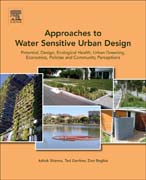
Approaches to Water Sensitive Urban Design: Potential, Design, Ecological Health, Economics, Policies and Community Perceptions
Sharma, Ashok
Gardner, Ted
Begbie, Don
Approaches to Water Sensitive Urban Design: Potential, Design, Ecological Health, Economics, Policies and Community Perceptions covers all aspects on the implementation of sustainable storm water systems for urban and suburban areas whether they are labeled as WSUD, Low Impact Development (LID), Green Infrastructure (GI), Sustainable Urban Drainage Systems (SUDS) or the Sponge City Concept. These systems and approaches are becoming an integral part of developing water sensitive cities as they are considered very capable solutions in addressing issues relating to urbanization, climate change and heat island impacts in dealing with storm water issues. The book is based on research conducted in Australia and around the world, bringing in perspectives in an ecosystems approach, a water quality approach, and a sewer based approach to stormwater, all of which are uniquely covered in this single resource. Presents a holistic examination of the current knowledge on WSUD and storm water, including water quality, hydrology, social impacts, economic impacts, ecosystem health, and implementation guidelinesIncludes additional global approaches to WSUD, including SUDS, LID, GI and the Sponge City ConceptCovers the different perspectives from Australia (ecosystem based), the USA (water quality based) and Europe (sewer based)Addresses storm water management during the civil construction stage when much of the ecological damage can be done INDICE: 1. History of Water Sensitive Urban Design/ Low Impact development Adoption in Australia 2. WSUD Approaches and their description 3. WSUD and stormwater quality 4. WSUD design guidelines and data needs 5. The Role of policy and regulations in WSUD Implementation 6. WSUD and flood prevention 7. WSUD Approaches in Sewer System overflow management 8. WSUD as sediment and erosion control devices 9. Water harvesting potential of WSUD Approaches 10. WSUD managing predevelopment hydrology 11. WSUD Improving Ecology health 12. WSUD protecting and managing stream morphology 13. Urban lakes and their roles 14. Economics of WSUD Approaches 15. Optimization of WSUD Systems: Selection, sizing and layout 16. Infrastructure and urban planning context for achieving visions of integrated urban water management and WSUD: the case of Melbourne 17. Integration of WSUD and mainstream special planning approaches: lessons from South Africa 18: Role of WSUD in building sustainable liveable suburbs 19. WSUD and urban heat island effect mitgation 20. The role of green roofs and living walls as WSUD approaches in a dry climate 21. Greening and cooling the city with local wastewater streams: a European perspective 22. Operation and maintenance of WSUD Features 23. Capacity building for WSUD Implementation 24. Community perception of the implementation and adoption of WSUD Approaches of stormwater management 25. Post implentation assessment of WSUD Approaches 26. WSUD Implentation in a precinct residential development: Australian case study 27. WSUD Case studies from Australia, USA, Europe, Asia: Best in Class
- ISBN: 978-0-12-812843-5
- Editorial: Woodhead Publishing
- Encuadernacion: Rústica
- Páginas: 626
- Fecha Publicación: 01/09/2018
- Nº Volúmenes: 1
- Idioma: Inglés
